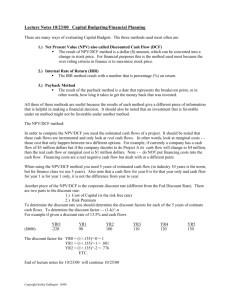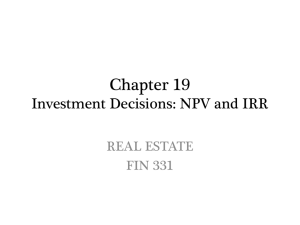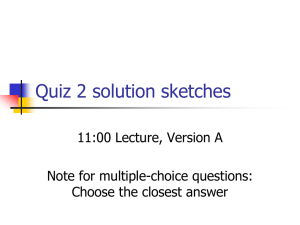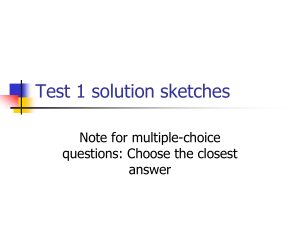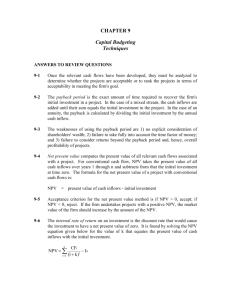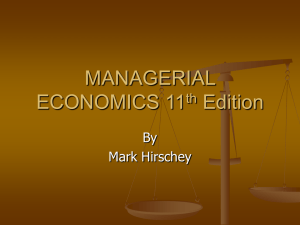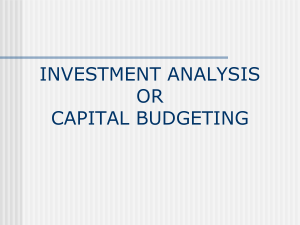End of Chapter 15 Questions and Answers
advertisement
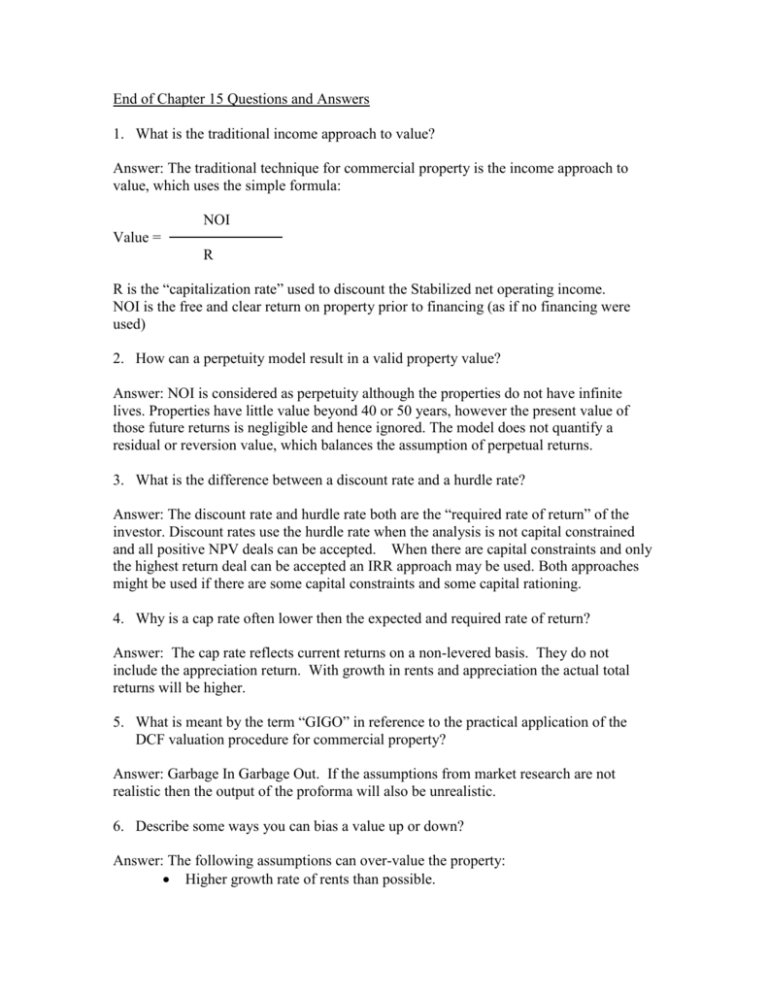
End of Chapter 15 Questions and Answers 1. What is the traditional income approach to value? Answer: The traditional technique for commercial property is the income approach to value, which uses the simple formula: NOI Value = R R is the “capitalization rate” used to discount the Stabilized net operating income. NOI is the free and clear return on property prior to financing (as if no financing were used) 2. How can a perpetuity model result in a valid property value? Answer: NOI is considered as perpetuity although the properties do not have infinite lives. Properties have little value beyond 40 or 50 years, however the present value of those future returns is negligible and hence ignored. The model does not quantify a residual or reversion value, which balances the assumption of perpetual returns. 3. What is the difference between a discount rate and a hurdle rate? Answer: The discount rate and hurdle rate both are the “required rate of return” of the investor. Discount rates use the hurdle rate when the analysis is not capital constrained and all positive NPV deals can be accepted. When there are capital constraints and only the highest return deal can be accepted an IRR approach may be used. Both approaches might be used if there are some capital constraints and some capital rationing. 4. Why is a cap rate often lower then the expected and required rate of return? Answer: The cap rate reflects current returns on a non-levered basis. They do not include the appreciation return. With growth in rents and appreciation the actual total returns will be higher. 5. What is meant by the term “GIGO” in reference to the practical application of the DCF valuation procedure for commercial property? Answer: Garbage In Garbage Out. If the assumptions from market research are not realistic then the output of the proforma will also be unrealistic. 6. Describe some ways you can bias a value up or down? Answer: The following assumptions can over-value the property: Higher growth rate of rents than possible. Lower forecasts for capital improvements than reasonable. High resale price of property (i.e. very low going-out cap rate) Unusually high occupancy rates with low vacancy assumptions. The following assumptions can under-value the property Low resale price of property (i.e. higher going-out cap rate) Unusually high operating expenses. Higher than normal vacancy rates 7. What is the approximate relationship between the cap rate, the discount rate, and the long-run average growth rate in property cash flow and value? Answer: The faster (higher the long run average growth rate) the expected growth in income, the lower the cap rate. The cap rate will be lower by approximately the growth rate in income. Very roughly speaking, the cap rate is equal to the current return less the growth rate in the current return, R=y-g, known as the Gordon growth rate model. The greater the risk the higher is the cap rate as the required rate of return (discount rate) is higher and the lower is value. 8. What is wrong with the following statement: “Investors typically overstate both the numerators and denominators in applying the DCF approach to commercial property, with the two types of errors largely canceling each other out, so that there is really no harm done by this type of mistake.” Answer: The harm is that investors will not see the returns that have been promised or expected. Incorrect numbers also undercuts the credibility of the DCF valuation framework and analysts lose faith in the ability of DCF modelers to tell them anything useful, because they have witnessed too much corruption with misinformation. 9. Why is a zero NPV deal “Okay”? Where is the profit for the investor in a deal in which NPV=0? Answer: The discount rate reflects the opportunity cost of capital; it includes the necessary expected return on the investment. This return is the normal amount of "profit" that would be required for an investment of this nature. Hence a zero NPV project indicates normal profit. 10. Why is the NPV of the typical deal zero when evaluated from a market value perspective? Answer: For the analyst and over time the market will bid prices up or down to average NPVs of 0. It is what should be expected over the long run or else the hurdle rates would be adjusted. Quantitative Problems 11. Consider a property with expected future net cash flows of $25,000 per year for the next 5 years (starting one year from now). After that, the operating cash flow should step up 20%, to $30,000, for the following 5 years. If you expect to sell the property 10 years from now for a price 10 times the net cash flow at that time, what is the value of the property if the required return is 12%? 5 10 t=1 t=6 V0 = 25000/(1.12)t + 30000/(1.12)t + 300000/(1.12)10 = $248,075 0 --> CF0, 25000 --> CF1, 5 --> N1, 30000 --> CF2, 4 --> N2, 330000 --> CF3 12 --> I/YR NPV --> 248075 12. In the previous question, suppose the seller of the building wants $260,000. (a) Should you do the deal? Why or why not? [Hint: What would be the Net Present Value of the deal for the buyer at $260,000?] (b) What is the IRR if you pay $260,000? How does this compare to the required return of 12%? (c) What is the IRR if you could get the seller to accept $248,075 for the property? What is the NPV at that price? (a) No: NPV = $248,075 - $260,000 = - $11,925 < 0 (b) 11.24% < 12.00% -260000 --> CF0, 25000 --> CF1, 5 --> N1, 30000 --> CF2, 4 --> N2, 330000 --> CF3 IRR --> 11.24 (c) By definition: IRR at $248,075 is 12.00% NPV at $248,075 is 0. 13. Suppose that the required return on the property in the problem 11 is 11% instead of 12%. What would the value of the property be? By what percentage has this value changed as a result of this 100 basis point change in the required return? [Note the sensitivity of property value to small changes in the expected return discount rate used in the denominators of the right-hand side of the DCF valuation equation.] Answer: $263,853. This is a 6.36% increase in value (263853/248075=1.0636) 1 point change in discount rate. from a 14. Go back to the property in the problem 11 with the 12% required return. What is the value of the property if the cash flow steps up 25% in year 6, to $31,250, instead of the original assumption of 20%? By what percentage has this roughly 1% per year change in the rent growth assumption (25% over 5 years instead of 20% over 5 years) changed the property value? [Note the sensitivity of property value to small changes in the percentage growth in expected cash flows in the numerators of the right-hand side of the DCF valuation equation.] Answer: $254,656. This is a 2.65% increase in value (254656/248075=1.0265) from a roughly 1 point change in market rent growth rate, even with 5-years fixed cash flows from vintage lease. 0 --> CF0, 25000 --> CF1, 5 --> N1, 31250 --> CF2, 4 --> N2, 343750 --> CF3 12 --> I/YR NPV --> 254656 15. An apartment complex has 1000 units of which on average 100 are vacant at any given time. Per unit, the rent is $400 per month, and the operating expenses are $1800 per year. If you expect both rents and expenses to grow at 3 percent per year, and the required return is 12.5 percent and the building value is expected to remain a constant multiple of its net income, then what is the NPV of a deal to buy the property for $25,000,000? [Hint: use the perpetuity formula: PV=CF1/(r-g).] Answer: +$1,526,300 16. What is the IRR of the above deal? [Hint: just invert the perpetuity formula and solve for r.] Answer: 13.08% 17. The table below shows two 10-year cash flow projections (in $ millions, including reversion) for the same property. The upper row is the projection that will be presented by the broker trying to sell the building. The bottom row is the realistic expectations. Suppose that it would be relatively easy for any potential buyers to ascertain that the most likely current market value for the property is about $10 million. (a) What going-in IRR (blended rate) will equate the presented cash flow projection to the observable $10 million present value (as of Year 0)? (b) What rate will equate the realistic projection to that same present value? (c) What is the most likely amount of “disappointment” in the ex post rate of return earned by an investor who buys this property believing the broker’s cash flow projection (i.e., difference in presented versus realistic return)? Year Presented Realistic 1 2 3 4 5 6 7 8 $1.0000 $1.0000 $1.0300 $1.0100 $1.0609 $1.0201 $1.0927 $1.0303 $1.1255 $1.0406 $1.1593 $1.0510 $1.1941 $1.0615 $1.2299 $1.0721 Answer: (a) 13%, (b) 11%, (c) 2% (200 basis points) likely disappointment. 9 10 $1.2668 $14.3525 $1.0829 $12.0305 18. Suppose a property worth $10,000,000 in the marketplace provides an initial annual gross income of $2,000,000 and a net operating income of $1,000,000. What is the GRM, and what is the cap rate prevailing in the property market for this type of property? Answer: GRM = $10 million / $2 million = 5. Cap rate = $1 million / $10 million = 10%.
